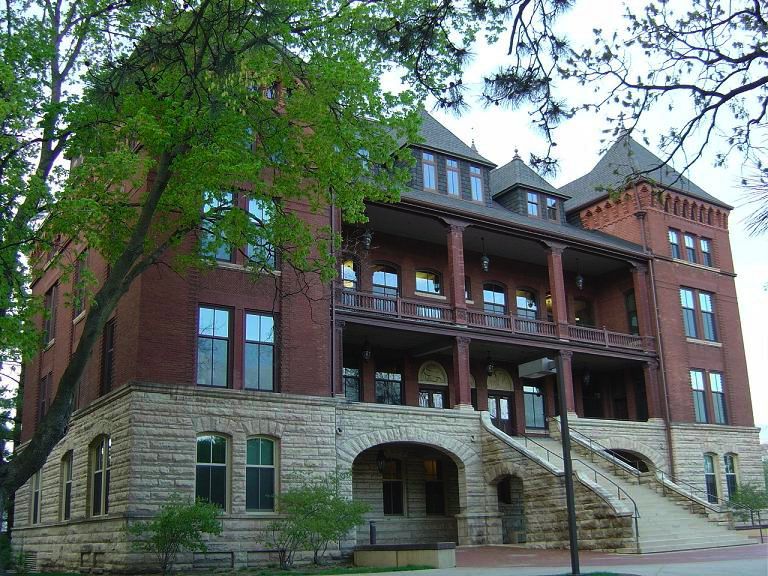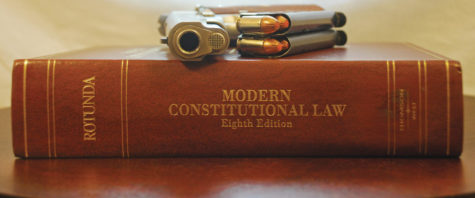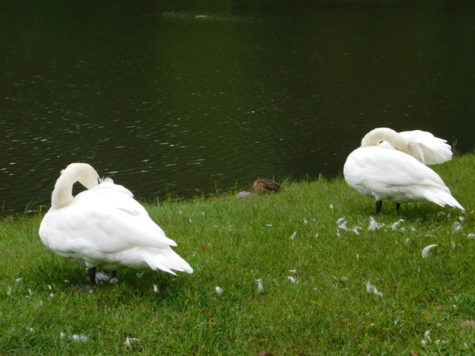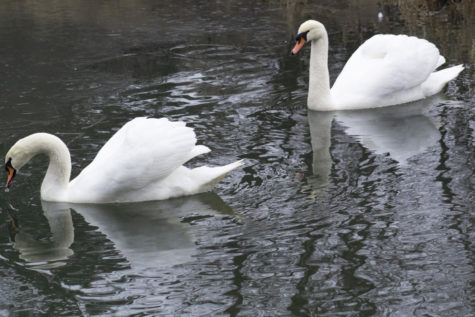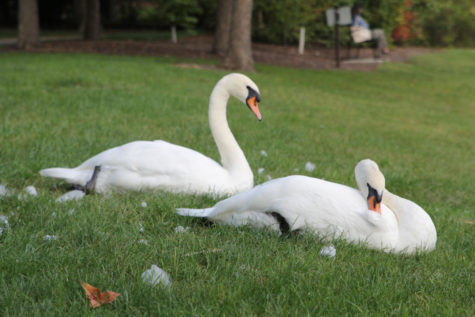Letter: Carrie Chapman Catt was a white supremacist
Letter writers Meron Wondwosen and Celia Naylor demand those who have defended Catt to correct their records.
July 2, 2020
We, as some of the original researchers involved with the debate on Carrie Chapman Catt, are writing to correct the record and add our voices to the reignited call to rename Catt Hall.
Much of the public debate surrounding Carrie Chapman Catt’s racism begins with two fallacies that have persisted for at least 25 years: 1) that the research Black women, then students and scholars at Iowa State, conducted regarding Carrie Chapman Catt lacked “proper research and proper understanding of history” and 2) that a historical figure’s racist statements need to be regarded within the context of the era in which they were made. Both sentiments reek of the kind of white privilege that was astounding in 1995 and continues to be tone deaf, insulting and anti-intellectual in 2020.
It is quite incredible that 25 years after we first raised concerns regarding Catt, Iowa State University, Jane Cox and other Catt advocates, including former and current directors of the Carrie Chapman Catt Center, continue to denigrate our scholarship. Just as disconcerting, if not ludicrous, is Jane Cox’s statement, as recent as last year, that it was difficult to conduct research in the 1990s and that she and others were unaware of Catt’s writings. Meron Wondwosen, then a rising junior, found the infamous Chapter 6 of “Woman Suffrage by Federal Constitutional Amendment” by Carrie Chapman Catt in the Library of Congress in 1996, and it was made available to the university at that time.
While the university can readily find the initial 1995 UHURU article, they refuse to acknowledge a second article written in 1996 also by Meron Wondwosen. That article titled, “White Woman’s Burden: Racism within the Women Suffrage Movement” was published in UHURU in August 1996. On footnote nine of this paper, Wondwosen cited “Woman Suffrage by Federal Constitutional Amendment” by Carrie Chapman Catt, 1917, which includes the chapter arguing enfranchising women would not hinder white supremacy, in fact, it would strengthen it.
The research and scholarship proving Catt made those statements exist and have been solid for at least 25 years. Black women conducted the research and published the findings including the citations. Iowa State, Jane Cox and other Catt advocates chose to intimidate and bully the students and, ultimately, bury this research.
This effort continues to this day — so much so that as recent as last July, Cox and Dianne Bystrom, former director of the Carrie Chapman Catt Center, were petitioning newspapers, including the New York Times, to either remove articles or include an editor’s note discounting the truth: that Catt authored a chapter advocating a violent, oppressive and murderous system as a means to court Southern votes. We said as much in 1995 and it remains an irrefutable fact today.
We are heartened to learn that in 2020, Jane Cox has finally discovered the offending chapter six and is now feverishly working to offer an apologia for white supremacy.
In addition to our work, Catt advocates also conveniently forget to mention a thesis written by Professor Deb Marquart, titled “No Sister of Mine: Voices from the Great Unwashed on Carrie Chapman Catt” documenting Catt’s xenophobic views. Catt also advocated excluding immigrants and other people of color from the right to vote.
In addition to denigrating our scholarship, Karen Kedrowski, director of the Carrie Chapman Catt Center has publicly lamented we lacked an understanding of proper history. Perhaps she meant an understanding of history that privileges the experiences, needs and wants of white women over those of Black women, as well as the weaponizing of white womanhood in the service of white supremacy.
In fact, it is Iowa State, Jane Cox and the Catt Center who need to revisit their version of history which allows them to gloss over the historical meaning of white supremacy in 1917 when Catt made those statements. A proper understanding of history would require Catt’s advocates to look beyond their position of privilege and acknowledge the profound harm caused by an advocacy of white supremacy.
Let’s explore the proper context of Catt’s statements. Carrie Chapman Catt wrote “[in] nine other states the number of white women exceeds the total negro population. Woman suffrage would so vastly increase the white vote that it would guarantee white supremacy if it otherwise stood in danger of overthrow.” Woman Suffrage by Federal Constitutional Amendment by Carrie Chapman Catt, p.77.)
Catt argued enfranchising white women would guarantee the maintenance of a violent, exploitative and murderous power structure. This isn’t hyperbole. White supremacy in the South in 1917 meant the lynching of Black men and women. According to the NAACP, between 1882 and 1968, there were 3,446 lynchings of African Americans — that were documented, we should note. Who knows the actual numbers of Black people who were hung from Southern trees, bodies burned and charred as mobs of white people watched and took “souvenirs” of what remained, with their children present no less!
The NAACP further notes that 79 percent of lynchings took place in the South, where Catt advocated the use of white women’s votes to maintain a violent power structure. The work of the Equal Justice Initiative also provides extensive evidence for the existence and persistence of lynchings in the United States.
White supremacy in 1917 also meant Jim Crow laws, which prescribed how Black people lived, worked and existed in the South and how race shaped and informed their second-class “position” throughout the entire country. White supremacy meant poll taxes, literacy tests as well as other unconstitutional and violent means to disfranchise Black people.
Catt was aware of these restrictions on the vote and how they functioned. When she wasn’t working to convince white southerners that the sheer number of white women would ensure white supremacy, she argued that the (unconstitutional) voting restrictions in place in the South would help maintain the white supremacist power structure. Catt notes “negro females over 21 exceed negro males in Alabama, Tennessee, Georgia, North Carolina and Virginia, but the restrictions in these states of property ownership represented by tax receipts, education and various other tests would fall more heavily upon women than men, and thus admit fewer women than men to the vote. If the South really wants white supremacy, it will urge the enfranchisement of women.” Ibid.
Cox has publicly asserted “Catt’s writing isn’t an emotional support of white supremacy, but a logical analysis on the claim held by Southern whites.” Catt’s writings need not be emotional for them to be effective; indeed, a calculated, methodical selling of white supremacy is chilling in its brutality.
Neither were Catt’s arguments “satirical commentary” as Cox has noted. For people of African descent, invoking white supremacy is not a rhetorical device to be used expediently. It is a policy, sanctioned by the state that allowed vigilante whites to exact extrajudicial murders of Black people, and the recent murders of Black people by white citizens reflects how this continues to be a reality in the contemporary era. Cox’s assessment of Catt’s statement is not only disingenuous, it is intellectually dishonest and frankly terrifying in its defense of a rhetoric which utilized white supremacy.
The second persistent argument from Catt advocates is she shouldn’t be judged by today’s standards, instead, we need to think of her within the context of her era. This argument erroneously presumed that marginalized people during Catt’s time shared her dehumanizing view of Africans. Our ancestors didn’t. They fought and resisted, many sacrificing their lives toward ending the racist system Catt promised white women suffrage would “guarantee … if it otherwise stood in danger of overthrow.”
In addition, countless whites during Catt’s time advocated for the end of racial inequality and challenged white supremacy in the U.S. For example, in 1909, some of the NAACP’s founding members were white women and men. Thus, viewing Catt’s comments within the context of lynchings, Jim Crow, segregation and disenfranchisement does not make her a more sympathetic figure. It’s even more jarring to think she was advocating for the continuance of such an inhumane system. And as we have always maintained, treating people with dignity and respect is not bound by time. These are timeless principles.
To recap, in their ever-shifting rationale and their dogmatic interest in preserving Carrie Chapman Catt’s “legacy,” the university and Catt advocates insisted: 1) they couldn’t find Catt writings, which have been available to the public since at least 1996; 2) the white supremacy chapter authored by Catt was misattributed to Catt; 3) Catt was a product of her racist time and should not be held up to modern scrutiny (as though treating people with dignity and not advocating for white supremacy should be limited to the current time); and 4) Catt did author the chapter but that Black women’s understanding of the history of our oppression and exclusion needed proper research, context and understanding.
This attempt to sanitize Catt, which has continued in the 25 years since we raised this issue, must be stopped.
It would appear it is Catt’s advocates who need to have a better understanding of history. We suggest that Cox, Bystrom, Kedrowski and the current ISU administration would benefit from a reading of Ida B. Wells’ writings on lynchings in the South and her national anti-lynching campaign. Since Cox, Bystrom, Kedrowski and ISU’s understanding of race and the role of Black women in history hasn’t improved in 25 years, we also suggest they spend time studying Professor Kimberlé Crenshaw’s work on intersectionality.
We would also add the work of other Black feminist scholars, including (but not limited to) Angela Y. Davis, Barbara Ransby and the late Rosalyn Terborg-Penn. Terborg-Penn’s book, “African American Women in the Struggle for the Vote, 1850-1920,” might be of particular interest.
Some 25 years after we alerted the ISU/Ames community about Catt’s remarks, ISU and the Catt Center continue to miss an opportunity to engage a new generation of anti-Black racism feminists. They could have used the intervening years to steep themselves in Black women’s scholarship and move the discourse forward on racism within the suffrage movement and racism in the present moment. Instead, they remain intransigent in their support of a white supremacist and, incredulously, they expect us to recant. As colleges, universities and other organizations across the country and the world boldly express their support for the Movement for Black Lives, it is telling that ISU’s response is in defense of Carrie Chapman Catt.
Indeed, it is Iowa State University, Jane Cox, the Catt Center and its directors, Kedrowski, Bystrom and other Catt advocates who owe us an apology. They are the ones who need to correct the record for using an elite white privileged lens to support and advocate for white supremacy.
As we have maintained for 25 years, an initial first step in that apology is the renaming of Carrie Chapman Catt Hall.
Meron Wondwosen is an Iowa State alum and current attorney. Wondwosen is also the co-founder of the September 29th Movement.
Celia E. Naylor is a professor of Africana studies and history at Barnard College of Columbia University. Naylor was the former director of the Margaret Sloss Women’s Center at Iowa State University from 1993 – 1997.

